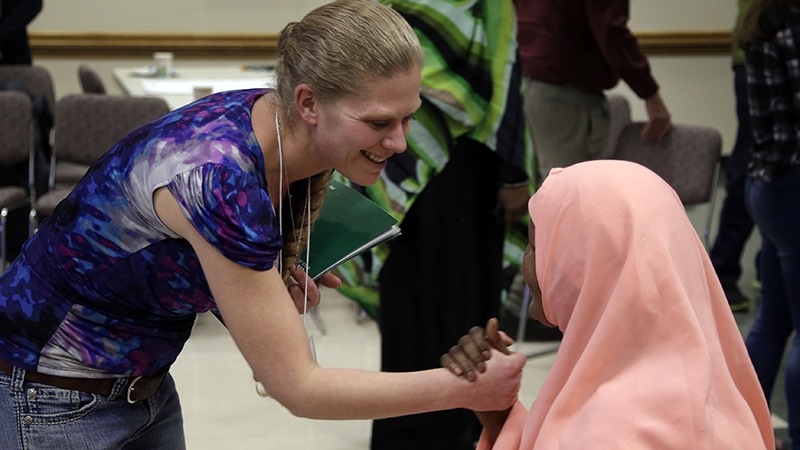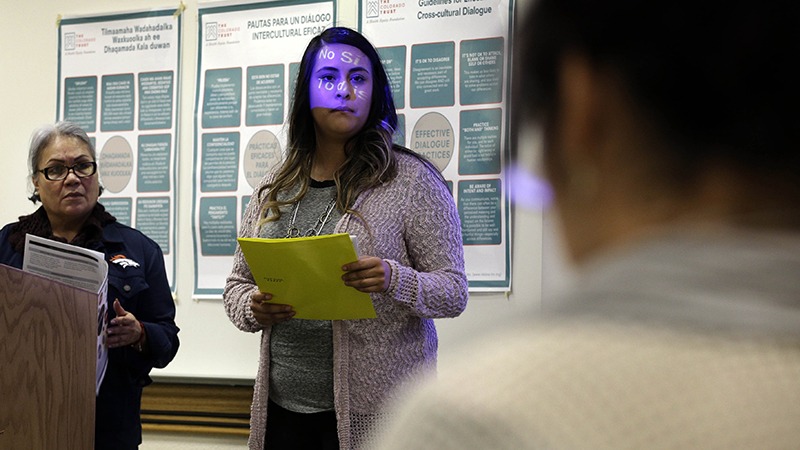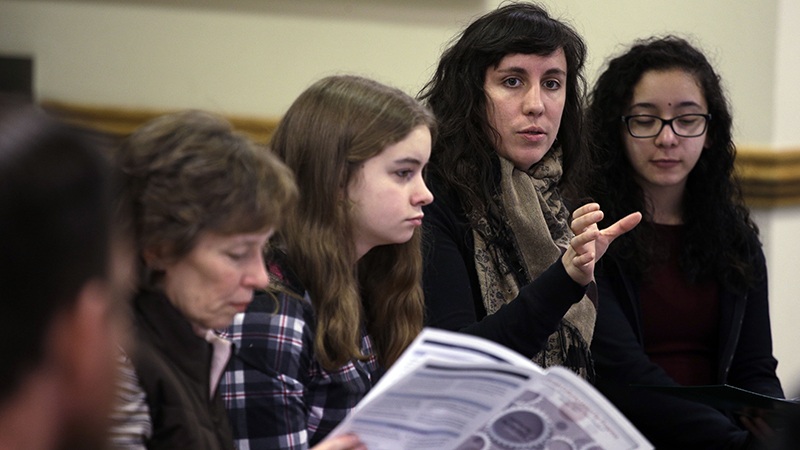Fort Morgan Is Getting Together
Leer en español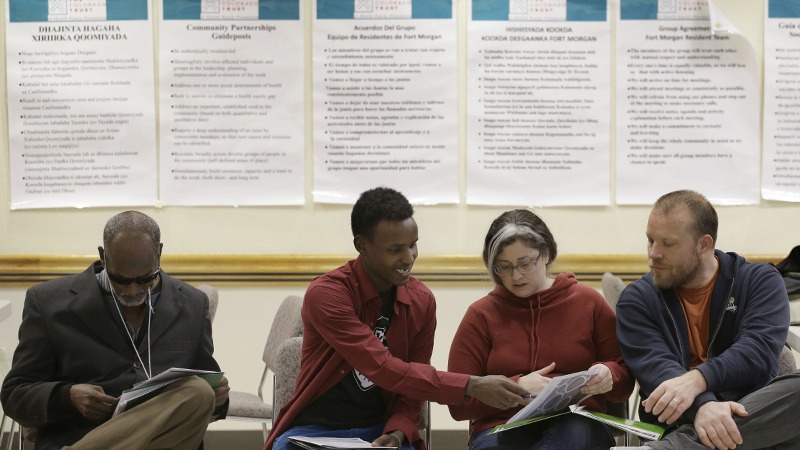
People living in Fort Morgan get together each Saturday to talk, make plans, and eat lunch. Photos by Joe Mahoney
By Kristin Jones
Richard Reiber, 77, was born in Fort Morgan, a city on the agricultural plains of eastern Colorado. He lives there still. His grandfather, an ethnic German from Russia, immigrated here for work; Reiber remembers hearing the stories of his grandfather’s arrival here, when he couldn’t understand others or make himself understood.
In the years since the elder Reiber’s arrival, Fort Morgan has seen successive waves of immigrants—Mexicans and central Americans, Somalis and other Africans—who come here for the steady work, many of them taking jobs in the Cargill meatpacking plant on the outskirts of the city. Many of them have faced similar struggles in adjusting to their new homes.
On a Saturday in early February, Reiber sat in a Fort Morgan community meeting that, on its surface, was about the most mundane of tasks: introducing newcomers to the guidelines and protocols for future meetings. And yet, by the end of it, Reiber was in tears.
“I want to appreciate all the different cultures,” he said to the group, choked with emotion. “We are communicating. We are getting together.”
The two-hour meeting was held in four languages. Clusters of people sat by language in the larger circle, their contributions translated into Spanish, English, Somali and French for the whole group.
That alone—the communication across languages and cultures—has made these weekly meetings “one of the most beautiful things that has ever happened to this community,” said Reiber later.
It’s been 11 months since residents in Fort Morgan started getting together for this work, sharing lunch and coming up with a plan for Fort Morgan to be a healthier and more equitable place. They call themselves Fort Morgan Cultures United for Progress.
Their work is part of The Colorado Trust’s Community Partnerships strategy; residents here have received initial funding to put together a comprehensive health equity plan addressing the challenges they themselves identify as the most pressing. The broad outlines of their plan are coming together: the community members want to find solutions for inequities in housing, education and recreation, taking on each issue through the lens of culture, belonging and communication.
If that’s an emotionally charged undertaking at times, it may be because the stakes are high. The city of 11,000 is a place of startling, and sometimes uneasy, diversity; around 19 percent of the city’s residents are foreign-born, according to 2015 census data. Hispanics and Latinos make up around 46 percent of the city, and another 5 percent are black. (Eric Ishiwata, PhD, a Colorado State University professor of ethnic studies who studies race relations in Fort Morgan, says he thinks the census undercounts the number of African residents, which he estimates at around 10 percent.)
The diversity of responses to these changes is equally striking. Some immigrants told me they have felt warmly welcomed in this small city, and quickly made friends across cultures. Some also said they have experienced racism or discrimination: subtly shut out of services that were available to others, or called ethnic slurs.
But the focus of the Fort Morgan Cultures United for Progress meetings hasn’t been so much on interpersonal relationships or conflict as on the invisible structures that get in the way of bringing the community together. The conversations digging into the root causes of inequities have brought revelations across communities.
“We discovered through [the] participation [of Muslim refugees] that it is against Koranic law to pay interest,” says Sue Boyett, who is a full-time coordinator for the group, naming one example. “In our system, the pathway to homeownership and to renting is so limited, because it depends on the ability of good credit history.”
Meanwhile, the work of exploring Fort Morgan’s recreational opportunities introduced some of the Somali refugees to parks they hadn’t heard of in three years of living there.
“There’s no structure for that kind of communication,” says Boyett. “Sadly, we realized how isolated many of our members were.”
At the Saturday meeting, a few of the newcomers to the group were asked what brought them there.
Eleazar Vallejo is originally from Tamaulipas, Mexico and has lived in Fort Morgan for 12 years. He heard about this group from Reiber’s daughter Pauline, a friend of his.
“I heard that we could help the community, do something for our community,” said Vallejo. “I have a lot of expectations, and I hope we can reach these goals for our community.”
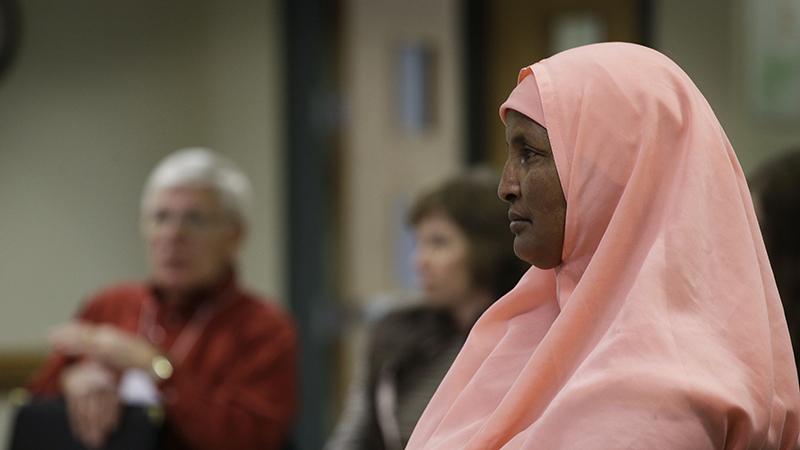
Fozia Mire, a new arrival in a coral hijab, said that education was the most important thing for her.
“What I would like to see is education for all people,” she said in Somali, as another resident interpreted. “Since I’m not educated, that’s the problem I see now. Maybe there is a special place for people to get training.”
These convenings take place against the backdrop of gathering unease for some.
Around 68 percent of votes in Morgan County went to President Donald J. Trump. His rhetoric about a forgotten America, and his promises to restore a former greatness, found resonance here, in a part of the state where farming towns have sometimes struggled as the heartland economy has transformed.
“If he does everything he said, we’d be sitting in a lot better place than we have for a long time,” said Phoebe Baquera soon after the election. Baquera grew up in nearby Sterling and moved to Fort Morgan nine years ago. She’s against abortion, and likes Trump’s promises to strengthen law enforcement and the military.
And yet, for many people who live here, the election brought only fear.
Dolores Del Campo, an immigrant from Mexico and a U.S. citizen, is an organizer for the group. She also works as an advocate for migrant students in Fort Morgan. Before she started this work in 2009, about half of the migrant kids dropped out of school. Last year, according to Del Campo, 95 percent graduated.
A lot of the children she serves didn’t come to school on the Wednesday after the election, she said. In the middle school, there were fights between white and Hispanic kids.
“The Hispanic people [are] a little scared. First, because a lot of them aren’t legal in this country,” Del Campo told me shortly after the election. “I feel the stress [of my students]. I try to tell them, ‘don’t worry.’”
But she’s worried. Will her students be separated from their families?
A week after his inauguration, Trump’s executive order banning entry to people from seven Muslim-majority countries, including Somalia, sent shockwaves through refugee communities here. (After that order was successfully challenged in federal court, Trump on March 6 issued a revised travel ban that dropped restrictions on Iraqis, but maintained them for Somalis and others.)
“We are so much scared about what’s going on,” said one Somali refugee a few days after the initial executive order was announced. He didn’t want to be named for fear that speaking out would result in official retaliation.
“We are listening to VOA,” he said, referring Voice of America, a U.S.-government funded radio station that broadcasts in Somali language. “We heard there is a refugee ban, then we heard it is specifically to Somalia.”
The shifting contours of the ban only added to the uncertainty, he said: “If we get in a car accident, will we be deported? How should we work? … What if we feel pressure from people where we are working?”
Members of the Somali community have been avoiding unnecessary trips out of the house, limiting themselves to work and school, he said.
This kind of fear and uncertainty—and the resulting isolation—is bad for the health of refugees and immigrants. Shanna Doughty, a member of the resident team, works with the International Association for Refugees, an organization that aids displaced people with the help of local churches. She cites research showing that refugees do best when they are well-connected with the broader community.
So does the community as a whole, she says. Doughty relates an anecdote from a conversation she had recently with a Somali friend who asked her: “Are you afraid of us? Are you afraid of Somalis?”
No, she replied.
“A lot of it has to do with my faith background,” says Doughty. “A lot of it has to do with, ‘I know you.’”
On a more practical level, any threat to immigration is a threat to the overall health of Fort Morgan, says Ishiwata, the Colorado State University professor.
“Cargill is the largest employer [in Fort Morgan] by a magnitude of four,” he says, citing his own research. “Cargill’s payroll at the Fort Morgan plant is over $77 million a year.”
Ishiwata runs through some other data: a huge majority of the operational staff at the plant (those who do the work of slaughtering the cows and processing the meat) are immigrants, or the children of immigrants. Roughly 80 to 100 positions at the plant are now unfilled, despite starting pay of $15.15 an hour; Cargill was unable to meet its full labor demands here even at the height of the recession.
“In order to stay operational, they need to find or recruit workers from outside of the community, because the local workforce is not willing to take those jobs,” says Ishiwata.
It is physically demanding and sometimes dangerous work, requiring workers to take the meat apart quickly with knives or other sharp tools as it zips by on hooks attached to a conveyer belt. A short staff puts even more pressure on the existing employees, several former and current Cargill workers told me.
Mike Martin, a spokesperson for Cargill, says that in any city this small, it’s hard for the community to generate enough workers to staff a plant this big, so bringing in new staff from elsewhere is important. He also adds that safety is a priority for the company, which he says has worked to reduce injuries to a minimum.
“I understand that there’s a popular narrative going around the nation right now that immigrants are stealing American jobs. Maybe that’s true in other industries,” says Ishiwata. “In this particular industry, that is not the case.”
Putting it bluntly, he says: “Stores will shut down, teachers will be laid off, the tax base will drop if Cargill cannot maintain their operations because of insufficient labor.”
The Saturday afternoon gathering of Fort Morgan Cultures United for Progress isn’t the only effort to integrate the community here. It builds off the initiative of people like Ishiwata and organizations like OneMorgan County, which has been working since 2005 to bridge cultures and languages here through programs like language and citizenship classes, trainings in intercultural communication and an annual International Music Fest each April. (OneMorgan County is a past grantee of The Trust.)
But this is perhaps the most grassroots effort. Nobody told the members of Fort Morgan Cultures United for Progress what to work on or how to do it; the focus areas of housing, education and recreation, and the emphasis on cross-cultural communication and cohesion, were things the community members determined on their own after countless hours of research, discussion and deliberation.
Their work has remained steady through the changing political landscape.
The day after the election, a male student with a white parent and a Hispanic parent asked Del Campo if she was ready to go back to Mexico.
Del Campo has practiced responses for questions like this, and she tries to model them for the benefit of her students.
“I say to him, ‘Yes. I have a car there. I have a house. I’m bilingual,’” she said. “‘Are you ready to stay here?’”
In fact, Del Campo told me, she isn’t going anywhere.
And, despite any fears, people have kept showing up for the Saturday meetings.
Many of them have pledged to keep coming together for as long as it takes.
“Fort Morgan is all of our communities,” said Baquera. “We’ve got to learn how to work together.”
“I think we are ready to survive,” said Del Campo.
